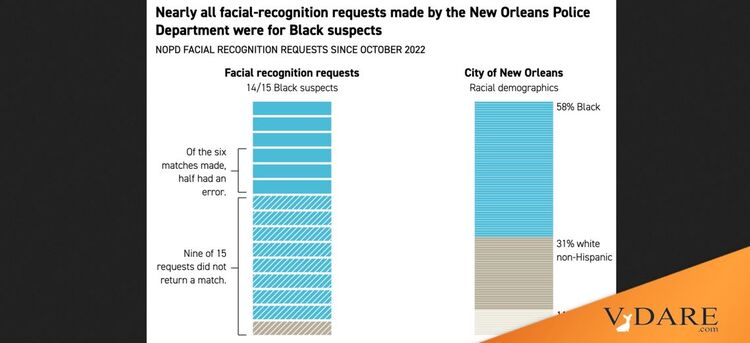


By Steve Sailer
11/03/2023
From Politico:
Records obtained and analyzed by POLITICO reveal the practice failed to identify suspects a majority of the time and is disproportionately used against Black people.
By ALFRED NG
10/31/2023 05:00 AM EDT
In the summer of 2022, with a spike in violent crime hitting New Orleans, the city council voted to allow police to use facial-recognition software to track down suspects — a technology that the mayor, police and businesses supported as an effective, fair tool for identifying criminals quickly.
A year after the system went online, data show that the results have been almost exactly the opposite.
Records obtained and analyzed by POLITICO show that computer facial recognition in New Orleans has low effectiveness, is rarely associated with arrests and is disproportionately used on Black people.
The first facial recognition search under the new policy occurred on October 21, 2022, using surveillance footage to help identify a Black man suspected of a shooting by matching his picture with a database of mugshots. The results: “Unable to match, low quality photo.” Over the next year, the NOPD would see a string of largely similar results.
A review of nearly a year’s worth of New Orleans facial recognition requests shows that the system failed to identify suspects a majority of the time — and that nearly every use of the technology from last October to this August was on a Black person.

The CDC WONDER database reports that 243 out of 279 homicide victims in Orleans Parish (i.e., New Orleans) were black in 2022. Almost certainly, an even higher percentage of the homicide perps were black.
Although it has not led to any false arrests, which have happened in other cities, the story of police facial identification in New Orleans appears to confirm what civil rights advocates have argued for years, as police departments and federal agencies nationwide increasingly adopt high-tech identification techniques: that it amplifies, rather than corrects, the underlying human biases of the authorities that use them.
“This department hung their hat on this,” said New Orleans Councilmember At-Large JP Morrell, a Democrat who voted last year against using facial recognition and has seen the NOPD data. Its use of the system, he says, has been “wholly ineffective and pretty obviously racist.” …
But the New Orleans records reveal there’s a human element as well: A system can land unfairly on the community because it’s selectively used on a particular group. …
In the 15 facial recognition requests that actually went through, records show that nine of them failed to make a match. And among the six matches, three of them turned out to be wrong.
On the other hand, the well-funded and traditionally pretty competent NYPD has been using facial recognition for a dozen years now and appears to be getting efficient with it: “The New York Police Department, one of the largest in the U.S., had used facial recognition since 2011, but only disclosed in 2019 that its facial recognition system made 2,510 potential matches out of 9,850 requests that year. It did not share how many of those matches were false positives.” 2510 matches in 2019 is a sizable number. It could be that the NOPD might eventually get better at using its new facial recognition toy.
Only one of those 15 requests was for a white suspect.
As we all know, white residents of New Orleans, such as historians Stephen Ambrose, Douglas Brinkley, and writers Ann Rice, Walter Isaacson, and Michael Lewis, are notoriously homicidal.
… The first and only arrest based on facial-recognition technology occurred in September, 11 months after the New Orleans City Council lifted the ban.
“The data has pretty much proven that advocates were mostly correct,” said Morell, the city councilor. “It’s primarily targeted towards African Americans and it doesn’t actually lead to many, if any, arrests.” …
Georgia State University’s Thaddeus Johnson published a research paper last October that found police departments reported a 55 percent increase in arrests of Black adults after they started using facial recognition, while having a 21 percent drop in arrests of white adults. …
One potential explanation, he said, is that facial recognition systems rely on criminal databases that are already heavily skewed toward non-white people — meaning that software asked to find “suspects” would be drawing from a database of majority Black people. …
In 2020, a Detroit police department report on its facial recognition use disclosed that the technology was used on Black people in 97 percent of cases, reflecting the racial bias that New Orleans’ data also showed.
There are all those murderous Chinese tongs running amok in Detroit.
What goes unspoken eventually becomes inconceivable. You aren’t supposed to report on racial breakdowns in crime stats, so a huge number of journalists these days don’t have access to the knowledge that of course the vast majority of uncleared murders in New Orleans and Detroit were committed by blacks. They kind of know it when looking for an apartment, but they don’t know it when writing articles.